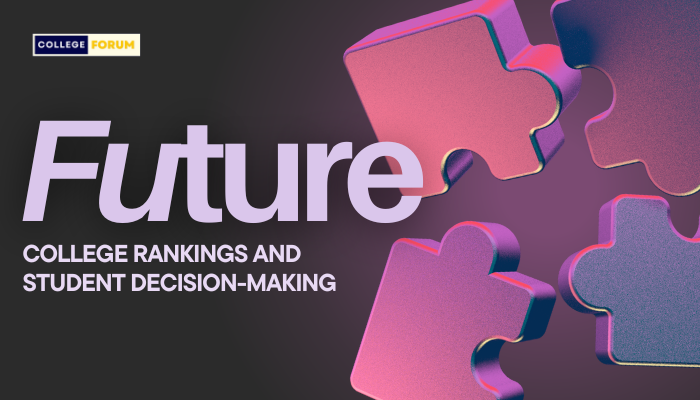The Impact of College Rankings on Student Decision-Making
The Impact of College Rankings on Student Decision-Making Choosing the right college is one of the most critical decisions students will make in their lives, significantly shaping their academic journeys and future careers. Given the vast array of options available, students often seek reliable guidance to make informed choices. College rankings have emerged as a vital tool in this decision-making process, offering an ostensibly objective measure of an institution’s quality and prestige. This blog delves into the profound impact of college rankings on student decision-making, providing an in-depth analysis of their benefits and drawbacks. Furthermore, we will highlight how College Forum serves as the best platform for students to find the best colleges, offering detailed and personalized insights beyond mere rankings. Understanding College Rankings Definition and Purpose College rankings are systematic evaluations of higher education institutions, designed to assist students and parents in making informed decisions about where to apply and enroll. These rankings assess colleges and universities based on various criteria, aiming to provide a comparative analysis of educational quality. Major Organizations and Publications Several organizations and publications are renowned for their college rankings. Prominent among them are: U.S. News & World Report: Known for its comprehensive methodology, it evaluates institutions based on factors such as graduation rates, faculty resources, and academic reputation. Times Higher Education (THE): Focuses on global rankings, assessing universities on teaching, research, international outlook, and industry income. QS World University Rankings: Evaluates global universities based on academic reputation, employer reputation, faculty/student ratio, and citations per faculty. Criteria Commonly Used Common criteria in college rankings include: Academic Reputation: Based on surveys of academic professionals and employers. Faculty Resources: Including faculty qualifications, student-to-faculty ratio, and research output. Graduation and Retention Rates: Indicators of student satisfaction and institutional effectiveness. Financial Resources: Reflecting the institution’s financial health and its investment in academic resources. Student Selectivity: Admission rates and standardized test scores of incoming students. Historical Context of College Rankings Evolution Over the Years College rankings have evolved significantly since their inception. Initially, they focused primarily on academic reputation and selectivity. Over time, the methodologies have become more complex, incorporating a broader range of indicators to provide a more nuanced evaluation. Changes in Ranking Methodologies Methodologies have continually adapted to address criticisms and improve accuracy. For instance, U.S. News has periodically revised its criteria to place greater emphasis on student outcomes and institutional effectiveness. Influence of Globalization Globalization has increased the importance of international rankings, such as QS and THE. These rankings help students from around the world compare institutions across different countries, influencing their decisions to study abroad. The Influence of College Rankings on Student Decision-Making Perceptions of Quality and Prestige College rankings significantly influence perceptions of quality and prestige. Higher-ranked institutions are often perceived as offering superior education and better career prospects, making them more attractive to prospective students. Shaping Student Choices Rankings play a crucial role in shaping student choices. According to surveys, a large percentage of students and parents consider rankings when making college decisions. High rankings can boost an institution’s visibility and appeal, while lower rankings may deter applicants. Statistics on Student Reliance on Rankings Statistics highlight the reliance on rankings: A study by the American Council on Education found that over 60% of students consider rankings important in their decision-making process. According to a survey by the National Association for College Admission Counseling, 70% of college-bound students use rankings as a factor in their application decisions. Benefits of College Rankings Simplification of the Selection Process Rankings simplify the college selection process by providing a starting point for research. They offer a consolidated list of institutions, making it easier for students to narrow down their choices. Providing a Starting Point Rankings help students identify potential colleges that match their academic interests and career goals. They offer an initial framework for further exploration and comparison. Highlighting Overlooked Colleges Rankings can bring attention to lesser-known colleges that excel in specific areas, encouraging students to consider a broader range of options. Encouraging Institutional Improvement The competitive nature of rankings motivates colleges to improve their performance in various areas, such as academic quality, student services, and research output. Institutions strive to climb the rankings, often leading to enhancements in their offerings and infrastructure. Criticisms of College Rankings Overemphasis on Prestige and Selectivity Critics argue that rankings place too much emphasis on prestige and selectivity, which may not accurately reflect the quality of education and student experience. This focus can lead institutions to prioritize rankings over substantive improvements that benefit students. Potential Biases in Methodologies Ranking methodologies can be biased, favoring certain types of institutions. For instance, research universities may score higher due to their extensive publications and funding, while smaller colleges that excel in teaching may be undervalued. Impact on Institutional Behavior The pressure to perform well in rankings can influence institutional behavior, sometimes negatively. Colleges might allocate resources to areas that improve rankings rather than those that directly benefit students, such as increasing marketing budgets or inflating selectivity metrics. Case Studies Colleges Benefiting from High Rankings High rankings can lead to increased applications and higher enrollment rates. For example, institutions like Harvard and Stanford consistently attract top-tier students and significant funding, partly due to their prestigious rankings. These institutions benefit from a virtuous cycle where high rankings attract high-caliber students, who in turn contribute to the institution’s success and further bolster its ranking. Misleading Rankings and Student Outcomes Conversely, some students may be misled by rankings, choosing institutions that do not align with their personal needs and goals. For example, a high-ranking university might not have the best program for a student’s specific academic interest, leading to dissatisfaction and potential transfer. There are cases where students, lured by the prestige of a high-ranking institution, find themselves in programs that do not match their learning style or career aspirations. Comparative Analysis of Student Outcomes Comparing student outcomes from highly ranked versus lesser-ranked institutions reveals mixed results. While graduates from top-ranked schools often have access to better
The Impact of College Rankings on Student Decision-Making Read More »







